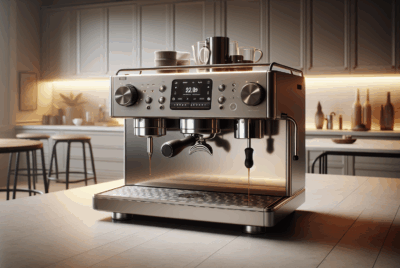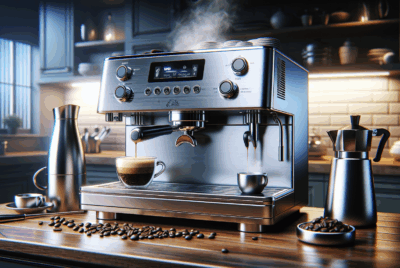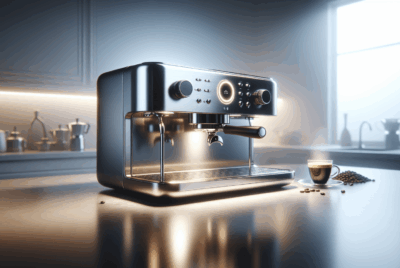Espresso Machine Maintenance: Essential Tips for Longevity
As an Amazon Associate, I earn from qualifying purchases, at no additional cost to you. Disclaimer
Taking care of your espresso machine is key to enjoying a great cup of coffee every time.
Regular cleaning and maintenance ensure the machine works properly and delivers the best flavor. Without it, your morning brew could start tasting off, and bigger problems might develop.

I find that simple tasks like wiping down surfaces, checking the water filter, and descaling help in preventing bigger issues.
By doing these regularly, you can keep your machine in top condition. Investing a little time into maintenance now can save you from headaches later.
Keeping track of maintenance schedules is important too. Some tasks, like cleaning the drip tray, should be done daily, while others, like descaling, need attention every few months.
Creating a routine helps keep your machine functioning well and prolongs its life.
Understanding Your Espresso Machine
When it comes to espresso machines, knowing the parts and water quality is crucial for great coffee. Each component plays a role, and using high-quality water affects flavor and longevity.
Components and Functionality
The espresso machine has several key parts. The boiler is important as it heats water to the right temperature for brewing.
Then there’s the group head, where water meets coffee grounds to make espresso. The pump works to move water through the machine with the right pressure.
Next is the portafilter, which holds the coffee grounds during extraction.
Keeping it clean ensures the best taste. The steam wand is used to froth milk for drinks like lattes.
Regular cleaning of these parts helps keep everything in good working order and ensures great espresso every time.
Understanding Water Quality and Hardness
Using quality water affects the taste and the life of the machine. Filtered water is important because it removes impurities, making the espresso taste better.
Tap water can have minerals like calcium and magnesium, leading to water hardness.
Hard water results in limescale buildup, which can damage the machine over time.
To prevent this, I filter my water or use bottled water with low mineral content. This helps to protect the machine and ensure that the espresso has the best possible flavor.
Regularly checking water quality prevents problems and keeps the machine running smoothly.
Daily Maintenance Routines
As someone who regularly maintains an espresso machine, I know the importance of daily care. From a quick cleaning after each use to handling coffee residue and oils, these essential steps extend the life of the machine and improve your coffee experience.
Quick Cleaning Steps
Each time I finish making espresso, I start with a simple routine.
First, I remove and clean the portafilter to prevent any coffee grounds from sticking.
A quick rinse of the group head ensures that any leftover coffee and oils are washed away, which helps in keeping the machine fresh.
Next, I wipe down the steam wand with a damp cloth immediately after use. This prevents milk from drying on it, making the wand easier to clean later on.
Consistent attention to these quick cleaning steps keeps the machine working smoothly and efficiently.
Handling Coffee Residue and Oils
Coffee residue can build up quickly and affect the espresso’s flavor. I make it a point to clean the machine’s parts that come in contact with coffee every day.
One of the critical areas to watch is the portafilter, which needs to be thoroughly cleaned to avoid any stale coffee oils.
I use a specific espresso machine cleaning solution for this task. Just a small amount goes a long way.
A regular wipe down of the machine’s outer surfaces also helps in maintaining its appearance and function. This approach keeps my machine in top condition and the coffee tasting great.
Weekly Maintenance Procedures

I take weekly maintenance seriously to keep my espresso machine in peak condition. This involves deep cleaning to remove buildup and inspecting parts for wear and damage.
Deep Cleaning Process
Every week, I do a deep clean of my espresso machine.
I start by backflushing the machine using a special espresso machine detergent. This step is crucial for removing coffee oils and residues that may clog the machine.
After placing the detergent into the blind filter, I run the pump for about 10 seconds, stopping and starting repeatedly.
I continue this process for a few cycles until I’m certain it’s clean. Then, I rinse thoroughly without the detergent to avoid any soapy flavors in my next brew.
It’s important to follow the cleaning schedule to prevent long-term buildup and ensure optimal performance.
Additionally, I check and clean the steam wand by soaking it in a mixture of water and detergent.
Inspecting for Wear and Damage
While cleaning, I also inspect the machine for signs of wear and damage.
I check the portafilter and group head seals. If they show wear, I replace them to keep the water pressure consistent.
I pay attention to any unusual noises or leaks. A quick look at the water level sensor and steam wand can reveal possible issues.
It’s easier to handle small problems right away before they lead to bigger repair costs. Regularly maintaining these parts ensures my espresso machine runs smoothly.
Descaling Your Espresso Machine

Descaling your espresso machine is essential to prevent scale buildup, which can harm your machine and affect coffee taste. With the right descaling solution, you can easily remove mineral deposits.
When and How to Descale
I recommend descaling about once every three months, though frequency can vary based on water hardness.
To start, turn off the machine and let it cool. Remove any water or coffee grounds. Then mix a descaling solution with water, following the instructions on the package.
Pour this solution into the water tank. Next, turn the machine on and run a full cycle, letting the solution pass through as if you’re making coffee.
After the solution runs through, refill the tank with fresh water. Repeat the cycle to rinse out the remaining solution. This ensures no residue remains, protecting both the machine and your coffee.
Choosing the Right Descaling Solution
To choose the best descaling solution, look for products that are specifically designed for espresso machines. These are formulated to break down mineral deposits without damaging the machine.
Avoid vinegar as it might leave a strong odor and is not as effective.
Consider the material of your espresso machine. Some solutions are better for certain metals. Always check the manufacturer’s recommendations for descaling products.
Make sure to read user reviews or ask for suggestions if unsure. Follow the guidelines on the product to get the best results. Choosing a good descaling product helps keep your machine running smoothly and ensures your coffee stays delicious.
Maintaining Water Filtration Systems

To keep your espresso machine running smoothly, maintaining the water filtration system is essential. I’ll cover how to choose the right filters for water quality and the steps for replacing and taking care of water filters.
Choosing Filters for Water Quality
Choosing the right water filter is crucial for the espresso machine’s performance and flavor. I look for filters that match the water quality in my area because different places have different water needs.
Some areas have hard water, which means a filter focusing on reducing minerals like calcium and magnesium is important.
Filter types include:
- Carbon filters: Good for taste and smell.
- Reverse osmosis: Removes many contaminants.
- Ion exchange: Ideal for hard water minerals.
I always check the compatibility of these filters with my espresso machine model.
Replacing and Upkeep of Water Filters
Replacing water filters is a straightforward process, but it must be done regularly to ensure filtered water and quality espresso.
Typically, I replace filters every two to three months, depending on the water usage and quality.
Steps for replacement include:
- Turn off the machine and disconnect it.
- Remove the old filter safely.
- Install the new filter by following instructions.
Maintaining filters involves cleaning the housing and checking for any blockages or build-up.
Regular maintenance and replacement keep my water clean and my espresso tasting great.
Managing the Steam Wand and Group Head

Keeping the steam wand and group head clean is key to making good espresso. Regular cleaning prevents milk and mineral buildup, which can affect taste and machine performance.
Cleaning and Preventing Milk Buildup
I clean the steam wand right after every use. It’s important to wipe it with a damp cloth to remove milk residue. Milk buildup can lead to blockages, impacting the wand’s ability to produce froth.
I also purge the steam wand by turning it on for a few seconds after cleaning. This clears any leftover milk inside.
For deep cleaning, I soak the steam wand in a mixture of water and vinegar weekly to prevent any mineral buildup. This way, the steam wand always works well.
Regular Group Head Maintenance
For the group head, I clean it daily to keep it free from coffee grounds and oils. After brewing, I use a brush to clear away debris.
Occasionally, I focus on cleaning the group head using a backflush.
To do this, I insert a blind filter and run the machine with a cleaning agent. This removes any built-up oils and ensures smooth water flow.
It’s also important to inspect mineral buildup, as calcium deposits can clog the group head over time. Cleaning often prevents this and keeps my espresso tasting its best.
Troubleshooting and Resolving Common Issues
In this section, I’ll guide you through fixing typical problems with your espresso machine. We’ll focus on tackling low water pressure and handling irregular flow or temperature issues.
Dealing with Low Water Pressure
Low water pressure can affect coffee taste and extraction. First, I check the water source and ensure it’s not blocked.
Sometimes, home espresso machines suffer from a kinked hose. This is an easy fix—just straighten it out.
It’s important to clean my machine regularly. I make it a habit to descale every few months to prevent mineral build-up.
I use a mixture of water and vinegar or a commercial descaling solution. This helps maintain optimal pressure.
I also inspect the pump and make sure it is working properly. If I suspect a damaged pump, seeking professional help is wise.
For low-pressure machines, I ensure the portafilter is securely locked in place. I find this minimizes pressure loss.
By addressing these steps, I improve water flow and espresso quality.
Addressing Irregular Flow or Temperature
Irregular flow or temperature can ruin a perfect cup. I start by checking the group head for blockages. Regularly cleaning this keeps the flow steady.
I also take a look at the thermostat or digital settings. A malfunction here can cause issues.
Another tip is to warm up the machine properly. I turn it on for at least 15 minutes before use. This ensures the components reach the right temperature.
If I notice fluctuations, I use a thermometer to test water heat. Consistent temperature is crucial for balanced flavor.
Cleaning the steam wand regularly is another practice I follow. A clogged wand can affect both flow and temperature.
Performing these simple checks helps avoid most common espresso issues and keeps my machine running smoothly.
Advanced Tips for Optimal Machine Performance
Maintaining an espresso machine requires attention to detail. In this section, I’ll cover how managing water backflushing can keep your machine clean and fine-tuning its settings can enhance extraction.
Understanding and Managing Water Backflushing
I’ve learned that water backflushing is crucial for keeping the espresso machine clean. Doing this regularly prevents coffee oil buildup, which can affect the taste and performance.
To perform a backflush, I always insert a blind filter into the portafilter. Then, I run the pump for about 10 seconds, releasing the pressure afterward. This should be repeated several times.
It’s key to use a cleaning powder once a week for a deeper clean.
Regular backflushing not only enhances taste but also extends the machine’s lifespan. I avoid skipping this, ensuring all residues are removed.
Keeping it on a schedule enhances the optimal performance of the machine.
Fine-Tuning for Perfect Extraction
Achieving perfect extraction is a matter of precision.
I start by adjusting the grind size; finer grinds usually require shorter brew times, while coarser grinds need longer ones.
I aim for an extraction time of 25 to 30 seconds.
I focus on the brew temperature, keeping it around 195°F to 205°F for espresso. The pressure also matters. I maintain about 9 bars for a smooth flow.
Dialing in these settings ensures that I get the right balance and flavor from my coffee beans.
To keep track, I document every adjustment made. This helps in recreating successful results and improving if needed.
Paying attention to these elements refines each shot.



